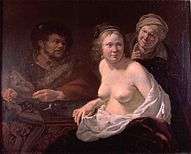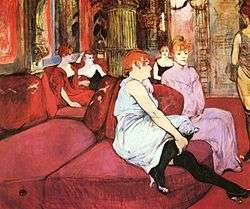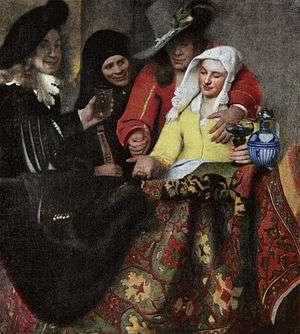Procuring (prostitution)

Procuring or pandering is the facilitation or provision of a prostitute or sex worker in the arrangement of a sex act with a customer.[1] A procurer, colloquially called a pimp (if male) or a madam (if female), is an agent for prostitutes who collects part of their earnings. The procurer may receive this money in return for advertising services, physical protection, or for providing, and possibly monopolizing, a location where the prostitute may engage clients. Like prostitution, the legality of certain actions of a madam or a pimp vary from one region to the next.
Examples of procuring include:
- trafficking a prostitute into a country for the purpose of soliciting sex
- operating a prostitution business
- transporting a prostitute to the location of their arrangement
- deriving financial gain from the prostitution of another
Overview
Procuring can often take abusive forms. Pimps may punish clients for physical abuse or failure to pay, and enforce exclusive rights to 'turf' where their prostitutes may advertise and operate with less competition.[2] In the many places where prostitution is outlawed, sex workers have decreased incentive to report abuse for fear of self-incrimination, and increased motivation to seek any physical protection from clients and law enforcement that a pimp might provide.
The pimp–prostitute relationship is widely understood to be abusive and possessive, with the pimp/madam using techniques such as psychological intimidation, manipulation, starvation, rape and/or gang rape, beating, confinement, threats of violence toward the victim’s family, forced drug use and the shame from these acts.[3][4] Marcus et al., however, suggested that these assumptions about abusive relationships represent stereotyped oppression narratives that may only represent a small percentage of the relationships between pimps and sexworkers.[5] Pimps can be arrested and charged with pandering and are legally known as procurers.[6] This combined with the tendency to identify pimping with African American masculinity may provide some of the explanation for why 62% of all "confirmed" human traffickers in the United States are African American men. In fact, it has recently been argued that some of the extreme examples of violence cited in the article below come primarily from such stereotyping supported by Hollywood screenwriters, selective and decontextualized trial transcripts, and studies that have only interviewed parties to sex commerce in institutions of rescue, prosecution, and punishment, rather than engaging rigorous study in situ.[7][8]
Legal status and debates about legality
In most places where prostitution is illegal, so is procuring, whether the relationship between the procurer and prostitute is formal or informal. Where prostitution is decriminalized or regulated, procuring may or may not be legal. If it is legal, however, it is only forms that do not involve threats or other forms of non-consensual acts towards the prostitute or other persons that are permitted. In jurisdictions where procuring is allowed, the regulations of if differ widely from place to place.
Procuring and brothels are legal in the Netherlands, Germany, Greece, New Zealand, most of Australia and Nevada among others.
In Canada, there was a legal battle regarding prostitution laws, ending in 2013 (see Bedford v. Canada). In 2010, in Ontario, Superior Court Judge Susan Himel overturned the national laws banning brothels and procuring, arguing that they violated the constitution guaranteeing "the right to life, liberty and security".[9] In 2012, Ontario Appeal Court reaffirmed the unconstitutionality of the laws.[10] The case has been appealed by the Canadian government, and was under trial at the Supreme Court of Canada.[11] On December 20, the law was struck down.
The United Nations 1949 Convention for the Suppression of the Traffic in Persons and of the Exploitation of the Prostitution of Others requires state signatories to ban pimping and brothels, and to abolish regulation of individual prostitutes. It states:[12]
"Whereas prostitution and the accompanying evil of the traffic in persons for the purpose of prostitution are incompatible with the dignity and worth of the human person and endanger the welfare of the individual, the family and the community"
The convention reads:
Article 1
The Parties to the present Convention agree to punish any person who, to gratify the passions of another:
(1) Procures, entices or leads away, for purposes of prostitution, another person, even with the consent of that person;
(2) Exploits the prostitution of another person, even with the consent of that person.
Article 2
The Parties to the present Convention further agree to punish any person who:
(1) Keeps or manages, or knowingly finances or takes part in the financing of a brothel;
(2) Knowingly lets or rents a building or other place or any part thereof for the purpose of the prostitution of others.
Various UN commissions however have differing positions on the issue. For example, in 2012, a UNAIDS commission convened by Ban Ki-moon and backed by UNDP and UNAIDS, recommended the decriminalization of brothels and procuring.[13][14][15][16]
Etymology
Pimping
The word pimp first appeared in English in 1607 in a Thomas Middleton play entitled Your Five Gallants. It is believed to have stemmed from the French infinitive pimper meaning to dress up elegantly and from the present participle pimpant meaning alluring in seductive dress. Pimp used as a verb, meaning to act as a pimp, first appeared in 1636 in Massinger's book, The Bashful Lover.[17] In the 18th and 19th centuries, the term was commonly used to refer to informers.[18] A pimp can also mean "a despicable person".[19] The term can also be applied to a person who is considered a ladies' man.[17]
The verb "pimping" came up in the early 17th century.[17] Rapper Nelly tried to redefine the word "pimp" by saying that it is an acronym for "positive, intellectual, motivated person." He created a college scholarship with the name "P.I.M.P. Juice Scholarship". Dawn Turner Trice of the Chicago Tribune argues that there is "something truly unsettling, to say the least, about attaching such a vile word to a scholarship" and expresses concern about the glamorization of the term.[20]
In the first years of the 21st century, a new meaning of the word has emerged in the form of a transitive verb pimp, which means "to decorate" or "to gussy up" (compare primp, especially in Scottish usage). This new definition was made popular by Pimp My Ride, an MTV television show.[17] Although this new definition paid homage to hip-hop culture and its connection to street culture, it has now entered common, even mainstream commercial, use.[21]
In medical contexts, the verb means "to ask (a student) a question for the purpose of testing his knowledge".[22]
Pandering
The word "pander", meaning to "pimp" is derived from Pandarus, a licentious figure who facilitates the affair between the protagonists in Troilus and Criseyde, a poem by Geoffrey Chaucer.[23] Pandarus appears with a similar role in Shakespeare's interpretation of the story, Troilus and Cressida.
Business of procuring

| Criminal law | |
|---|---|
| Elements | |
| Scope of criminal liability | |
| Severity of offense | |
|
|
| Inchoate offenses | |
| Offence against the person | |
|
|
|
| Crimes against property | |
| Crimes against justice | |
| Victimless crimes | |
|
|
| Crimes against animals | |
| Defences to liability | |
| Other common-law areas | |
| Portals | |
|
|
Pimping is sometimes operated like a business.[24] The pimp may have a bottom girl who serves as office manager, keeping the pimp apprised of law-enforcement activity and collecting money from the prostitutes.[25] Pimps recognize a hierarchy among themselves. The least respected, or newer pimps, are the "popcorn pimps" and "wannabes". A pimp who uses violence and intimidation to control his prostitutes is called a "Jonas pimp", while those who use psychological trickery to deceive younger prostitutes into becoming hooked into the system are called "finesse pimps". An important part of the business is obtaining and maintaining a selection of prostitutes. Losing one's prostitute to another pimp is known as being "peeled". Informing a pimp that one of his prostitutes has switched pimps is a professional courtesy, and any attempt to respond to this courtesy with violence will quickly get the violent pimp labeled a "Gorilla" or "Godzilla". Prostitutes who move between pimps often are labeled as a "Choosey Susie". In addition, a prostitute may "bounce" from pimp to pimp without paying the "pimp moving" tax.[26]
A large percentage of pimps in the United States are also documented gang members, which causes concerns for police agencies in jurisdictions where prostitution is a significant problem. Pimping rivals narcotic sales as a major source of funding for many gangs, this is particularly true with African-American gangs. Gangs need money to survive, and money equates to power and respect. While selling drugs may be lucrative for a gang, this activity often carries significant risk as stiff legal penalties and harsh mandatory minimum sentencing laws exist. However, with pimping, gang members still make money while the prostitutes themselves bear the majority of the risk. Pimping has several benefits to the gang that the pimp belongs to. These benefits include helping the gang recruit new members because the gang has women available for sex and the money brought in by prostitution allows gang members to buy cars, clothes and weapons, all of which help to recruit younger members into the gang by increasing the reputation of the gang in the local gang subculture. The presence of gangs (and weapons and drugs) is a virtual guarantee when prostitutes are present, which is why many law-enforcement agencies advocate taking an aggressive stance against prostitutes. Many vice units work to ascertain if the prostitute they have arrested has a pimp, and if so, they pressure them to provide information about their pimp and the gang involved. This information can then be used to go after the more serious and violent offenders.[27]
The pimp business has an internal structure – built around violence – for dealing with rule breakers. For example, pimps have been known to employ a "pimp stick", which is two coat hangers wrapped together, in order to subdue unruly prostitutes.[25] A variation is a "pimp cane", used for similar purposes. Another punishment for disobedient prostitutes is to "trunk" them, where the pimp locks the prostitute in the trunk of a car. Although prostitutes are supposedly free to move between pimps, this movement sometimes leads to violence. For example, a prostitute could be punished for merely looking at another pimp; this is considered "reckless eyeballing".[25] Violence is also used on customers, for example if the customer attempts to evade payment or becomes unruly with a prostitute.
Use of tattoos
Many pimps tattoo prostitutes as a mark of "ownership".[28][29] The tattoo will often be the pimp's street or even his likeness. The mark might be as discreet as ankle tattoo, or blatant as a neck tattoo, or large scale font across the prostitute's lower back, thigh, chest, or buttocks.[30]
Internet effect
Since the Internet became widely available, it has become the preferred medium for prostitution. Prostitutes increasingly use websites to solicit sexual encounters. In turn, pimps have used these sites to broker their women.[31]
The use of the Internet for prostitution as well as other changes in the sex industry have resulted in the disintermediation of prostitution, allowing prostitutes to deal with clients directly. This has rendered pimps largely superfluous, at least in the United States. In 2011, Wired reported that of 11 pimps working out of New York's midtown Manhattan in 1999, all were out of work within four years.[32]
Loverboy
Loverboy is slang for young men who lure underage girls into prostitution.[33] This is a significant problem in many countries, including the Netherlands,[34][35] and estimates place the number of victims at 1,500 per year.[36]
Although loverboys use kidnapping, gang rape, and other coercive and intimidating methods on victims, Dutch politician Jamila Yahyaoui reports as of 2009 only five cases resulted in convictions in one year in the Netherlands.[37]
Often, a more-frequently used tactic is to use social media and direct communication/seduction after which they are forced to engage in sexual intercourse with other people (customers), for example by threatening to expose nude photos taken of the girls, or by using drugs as an incentive (after ensuring they were addicted to them).
Because of their young age, the girls' fear and emotional dependence, and vagueness about what exactly happened, often loverboys and their associates may only be charged with having sex with a minor and thus receive short sentences.[36] The socialist party ROOD wants police to remove obstacles to girls reporting abuse and not to lose contact, while some municipalities are educating front-line workers to identify victims better.[38]
Pornography and procuring
Attempts have been made in the U.S. to charge pornographic-film producers with pandering under state law. The case of California v. Freeman in 1989 is one of the most prominent examples where a producer/director of pornographic films was charged with pandering under the argument that paying porn actors to perform sex on camera was a form of prostitution covered by a state anti-pandering statute. The State Supreme Court rejected this argument, finding that the California pandering statute was not intended to cover the hiring of actors who would be engaging in sexually-explicit but non-obscene performances. It also stated that only in cases where the producer paid the actors for the purpose of sexually gratifying themselves or other actors, could the producer be charged with pandering under state law. This case effectively legalized pornography in the State of California.[39][40][41] In 2008, the New Hampshire Supreme Court would issue a similar ruling (New Hampshire v. Theriault) which declared that producing pornography was not a form of prostitution under state law.[42]
- Procuring in art
-

The Procuress by Dirck van Baburen, 1622
-

The procuress by Jan G. van Bronckhorst, 1636–1638
-

At the procuress, by Jan van Bijlert, second quarter of 17th century
-

In Salon of Rue des Moulins, (La Fleur blanche), by Henri de Toulouse-Lautrec, 1894
Other notable pimps and madams
- Brenda Allen
- Polly Adler
- Ah Toy (madam)
- Sydney Biddle Barrows
- Don "Magic" Juan, born Donald Campbell
- Kristin Davis
- Heidi Fleiss (madam)
- Marguerite Gourdan (madam)
- Dennis Hof
- Xaviera Hollander
- Mary-Anne Kenworthy (madam)
- James Lipton
- Enriqueta Martí
- Elizabeth Needham
- Deborah Jeane Palfrey
- Justine Paris (madam)
- Jurjentje Aukes Rauwerda
- Lindi St Clair (madam)
- Fillmore Slim
- Iceberg Slim
- Sally Stanford
- Al Swearengen
- Anna Wilson (madam)
See also
- American Pimp, a 1999 documentary by the Hughes Brothers consisting of first person interviews with people involved in the pimping lifestyle in the U.S.
- Brothel
- Pandarus
- Prostitution
References
- ↑ Garner, B. & Black, H. (2004). Black's Law Dictionary. Belmont: Thomson/West.
- ↑ Zahniser, David (13 May 2008). "L.A. seeks to thwart sex trade on Figueroa". Los Angeles Times. Retrieved 27 September 2011.
- ↑ "55 Little Known Facts About... Human Trafficking". Random History. Retrieved 27 September 2011.
- ↑ Skinner, E. Benjamin (2008). A Crime So Monstrous: Face-to-Face with Modern-Day Slavery. Free Press. ISBN 978-0-7432-9007-4.
- ↑ Marcus, Anthony, et al. "Conflict and Agency among Sex Workers and Pimps: A Closer Look at Domestic Minor Sex Trafficking". The ANNALS of the American Academy of Political and Social Science May 2014 vol. 653 no. 1 225-246. doi: 10.1177/0002716214521993.
- ↑ "Pandering". Dictionary.com. Retrieved 2013-06-17.
- ↑ Horning, A. (2013). Peeling the onion: domestically trafficked minors and other sex work involved youth. Dialectical anthropology, 37(2), 299-307.
- ↑ Marcus, Anthony, Amber Horning, & Ric Curtis. 2014. “Child Sex Trafficking: Toward an Agent Centered Approach” in Rhacel Salazar Parreñas and Kimberly Hoang Human Trafficking Reconsidered: Rethinking the Problem, Envisioning New Solutions, New York: Open Society Institute.
- ↑ Canadian judge overturns brothel ban in Ontario, BBC 29 September 2010
- ↑ Ontario Appeal Court strikes down ban on brothels, CBC News, Mar 26, 2012
- ↑ "Canada's top court to hear prostitution challenge today | CTV News". Ctvnews.ca. 2013-06-13. Retrieved 2013-11-05.
- ↑ "Convention for the Suppression of the Traffic in Persons and of the Exploitation of the Prostitution of Others" (PDF). Retrieved 2014-04-29.
- ↑ Decriminalisation integral to the fight against HIV, Michael Kirby & Michael Wong, Australian Broadcasting Corporation, 13 JULY 2012
- ↑ U.N. Commission Calls for Legalizing Prostitution Worldwide, Amanda Swysgood, CNS News, July 23, 2012
- ↑ AIDS used as reason to legalize prostitutes, Cheryl Wetzstein, The Washington Times, August 2, 2012
- ↑ Risks, Rights & Health, GLOBAL COMMISSION ON HIV AND THE LAW, UNDP, HIV/AIDS Group, , July 2012, page 43 ("Recommendation"): "Repeal laws that prohibit consenting adults to buy or sell sex, as well as laws that otherwise prohibit commercial sex, such as laws against “immoral” earnings, “living of the earnings” of prostitution and brothel-keeping."
- 1 2 3 4 Jesse Sheidlower: A History of Pimping. What the word meant and what it means now. Slate.com, 11 February 2008
- ↑ "Pennsylvania Gazette, Nov 7, 1765, transcription". Smithsonian Source. Retrieved 2013-06-17.
- ↑ "Webster's College Dictionary", Random House, 2001
- ↑ Trice, Dawn Turner. "Scholarship is soured by unsavory name", Chicago Tribune, 27 April 2005.
- ↑ "Feet pimping". The Hook weekly. 20 September 2007. Retrieved 26 September 2007.
- ↑ Brancati, Frederick L. (7 July 1989). "The Art of Pimping". JAMA. 262 (1): 89. doi:10.1001/jama.1989.03430010101039.
- ↑ Classen, Albrecht (2010). Laughter in the Middle Ages and Early Modern Times: Epistemology of a Fundamental Human Behavior, Its Meaning, and Consequences. p. 462. ISBN 978-3110245479.
- ↑ "Really Really Pimpin' in Da South". Rotten Tomatoes. Retrieved 5 October 2015.
- 1 2 3 U.S. v. Pipkins, 378 F.3d 1281, (11th Cir. 2004).
- ↑ Western Michigan University, The Pimping Game. Archived November 13, 2010, at the Wayback Machine.
- ↑ O'Deane, Matthew (24 September 2010). "Prostitution & Gangs. Techniques for going after violent offenders".
- ↑ Urbina, Ian (27 October 2009). "RUNNING IN THE SHADOWS; For Runaways on the Street, Sex Buys Survival". The New York Times. p. 1. Retrieved 20 November 2010.
- ↑ Waters, Julie, "The Intersection of Law, Theology, and Human Trafficking in the Narrative of Joseph: Linking the Past to the Present" (2010). Second Annual Interdisciplinary Conference on Human Trafficking, 2010. Paper 8.
- ↑ Rowe, Claudia (June 26, 2008). "No way out: Teen girls sell bodies in Seattle". Seattle Post-Intelligencer.
- ↑ Poulsen, Kevin (February 25, 2009). "Pimps Go Online to Lure Kids Into Prostitution". Wired.
- ↑ Venkatesh, Sudhir (31 January 2011). "Features Inside the Mad Science of 7 Renegade Researchers Start Prison Economics: How Fish and Coffee Become Cash Play Q&A: Photog's Descent Into the Underworld 19.02 How Tech Tools Transformed New York's Sex Trade". Wired. Retrieved 26 February 2011.
- ↑ "StopLoverboysNU". StopLoverboys.nu. Retrieved 2013-06-17.
- ↑ Rossi, Alex (13 August 2010). "Dutch Girls Groomed By 'Loverboy' Pimps". Sky News. Retrieved 27 September 2011.
- ↑ "Loverboys | Radio Netherlands Worldwide". Rnw.nl. 23 September 2011. Retrieved 2013-06-17.
- 1 2 Krahe, Dialika (September 8, 2010). "Schoolgirls Controlled by Loverboys". Retrieved 27 September 2011.
- ↑ Crisafis, Angelique (18 August 2009). "'Loverboys' child prostitution scandal back in Dutch spotlight". The Guardian. Retrieved 27 September 2011.
- ↑ van der Horst, Loretta (29 June 2009). "Victims of 'loverboys' not taken seriously by Dutch police". Radio Netherlands. Retrieved 2 October 2011.
- ↑ "California v. Freeman". Caselaw.lp.findlaw.com. 1989-02-01. Retrieved 2013-11-05.
- ↑ "First Amendment Lawyer - Creating Adult Content Outside California". Firstamendment.com. Retrieved 2013-11-05.
- ↑ "faq: part 11: legal issues". rame.net. Retrieved 2013-11-05.
- ↑ Timmins, Annmarie (December 5, 2008). "Offer to tape sex nullifies conviction: 'It's not prostitution but speech, court says'". Concord Monitor. Retrieved October 26, 2015.
External links
![]() Media related to Prostitution at Wikimedia Commons
Media related to Prostitution at Wikimedia Commons
